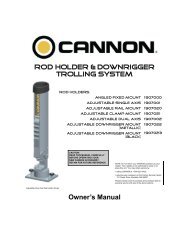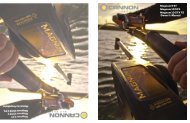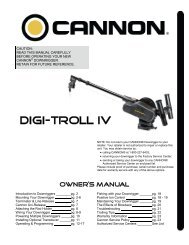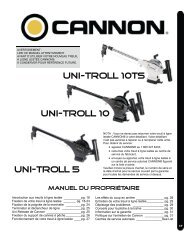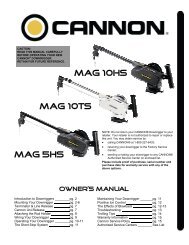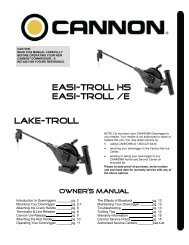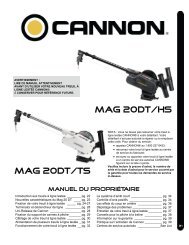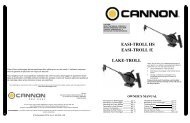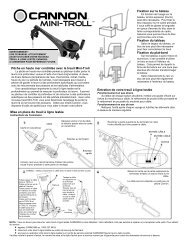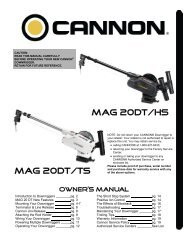UNI-TROLL & EASI-TROLL - Cannon Downriggers
UNI-TROLL & EASI-TROLL - Cannon Downriggers
UNI-TROLL & EASI-TROLL - Cannon Downriggers
- No tags were found...
Create successful ePaper yourself
Turn your PDF publications into a flip-book with our unique Google optimized e-Paper software.
Blowback ChartsBlowback Calculations8-Lb. Weight at 2, 4, and 6 MPH2 MPH4 MPHBLOWBACK.........................................................................................Simply stated, blowback is what happens to the downriggerweight when you pull it through the water behindyour boat. As your speed increases, so does the horizontaldistance between the weight and your downrigger.The faster you go, the farther the weight is behindyou. The farther the weight is behind you, the shallowerthe weight is.6 MPHActual Depth of Weight (ft.)The following charts provide you with blowback informationfor three sizes of <strong>Cannon</strong> downrigger weights pulledat three different speeds with no lures attached andwith no current. Current drag, water salinity and the useof non-<strong>Cannon</strong> products will affect your actual trollingdepth.Amount of Cable in Water (ft.)10-Lb. Weight at 2, 4, and 6 MPHAs an example, the fi rst chart shows that if you are trollingat 4 MPH with an 8 pound weight and you have 100FT. of cable in the water with no current; the downriggerball is actually at a depth of about 80 FT.2 MPH4 MPH6 MPHActualDepth of Weight (ft.)Amount of Cable in Water (ft.)12-Lb. Weight at 2, 4, and 6 MPH2 MPH4 MPH6 MPHActual Depth of Weight (ft.)13Amount of Cable in Water (ft.)www.cannondownriggers.comCOUP EN ARRIÈRE............................................................................En quelques mots, le coup en arrière est ce qui arriveau poids du treuil lorsque vous le tirez dans l’eauderrière votre bateau. Plus votre vitesse augmente,plus la distance horizontale entre le poids et votretreuil augmente. Plus vous allez vite, plus le poidss’éloigne derrière vous. Plus le poids s’éloigne derrièrevous, plus le poids se rapproche de la surfacede l’eau.Le tableau suivant contient de l’information sur lecoup en arrière pour trois dimensions de poids detreuil <strong>Cannon</strong> qui sont tirés à trois vitesses différentessans leurre et sans courant. La traînée du courant,la salinité de l’eau et l’utilisation de produits nonfabriqués par <strong>Cannon</strong> affecteront votre profondeur lade pêche à la traîne réelle.Par exemple, le premier tableau montre que si vouspêchez à la traîne à une vitesse de 6 km/h (4 mi/h)avec un poids de 4 kg (8 lb), et un câble de 30 m(100 pi) dans l’eau sans courant; la boule du treuilse trouve en fait à une profondeur de 24 m (80 pi)environ.12 livres Poids à 2, 4 et 6 mi/h2 mi/h4 mi/h6 mi/h13www.cannondownriggers.comCoup en arrièreProfondeur du poids réelle (pieds)Profondeur du poids réelle (pieds)Profondeur du poids réelle (pieds)Tableaux concernant le coup arrière8 livres Poids à 2, 4 et 6 mi/h2 mi/h4 mi/h6 mi/hLongueur du câble immergé (pieds)10 livres Poids à 2, 4 et 6 mi/h2 mi/h4 mi/h6 mi/hLongueur du câble immergé (pieds)Longueur du câble immergé (pieds)



